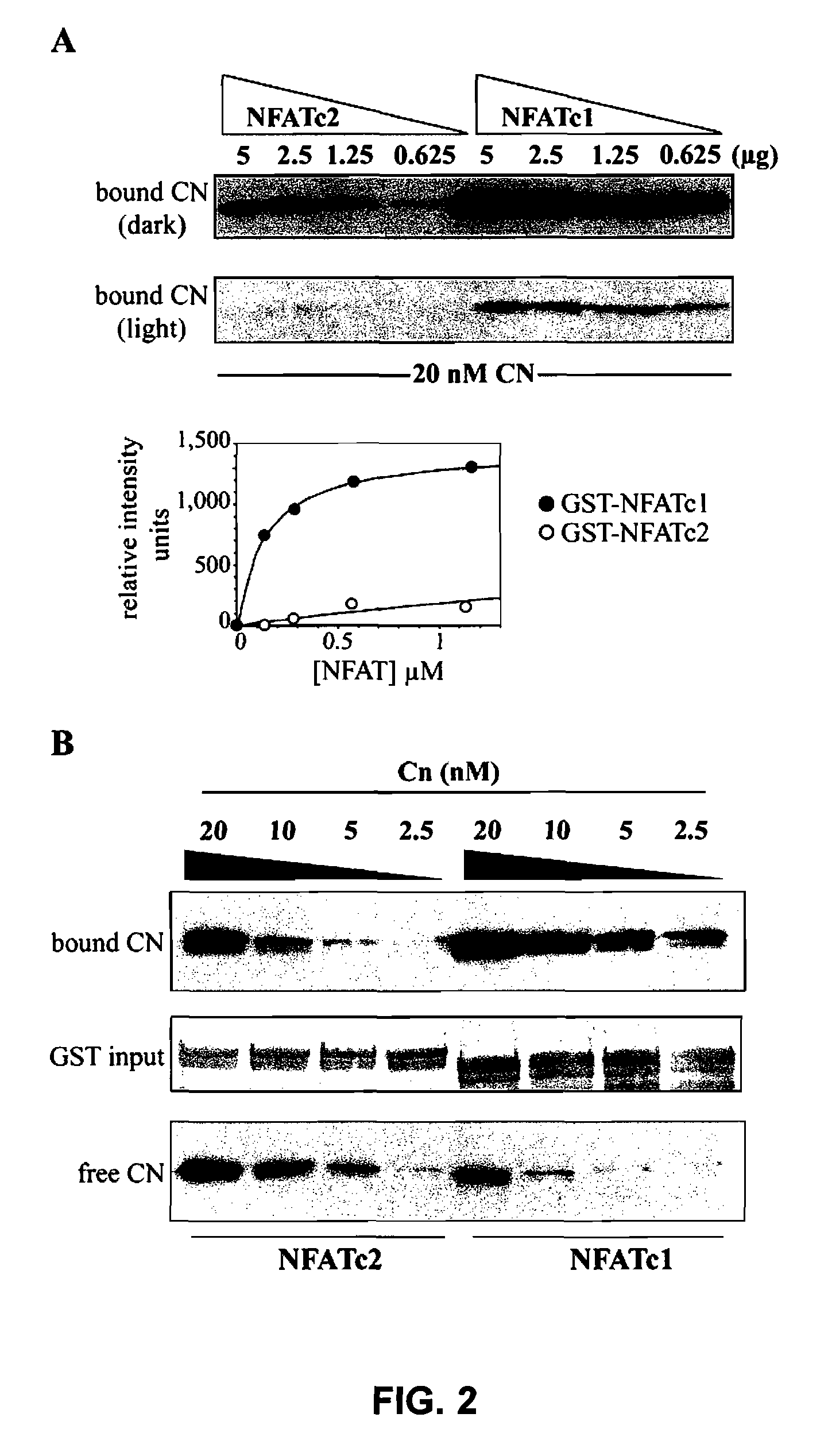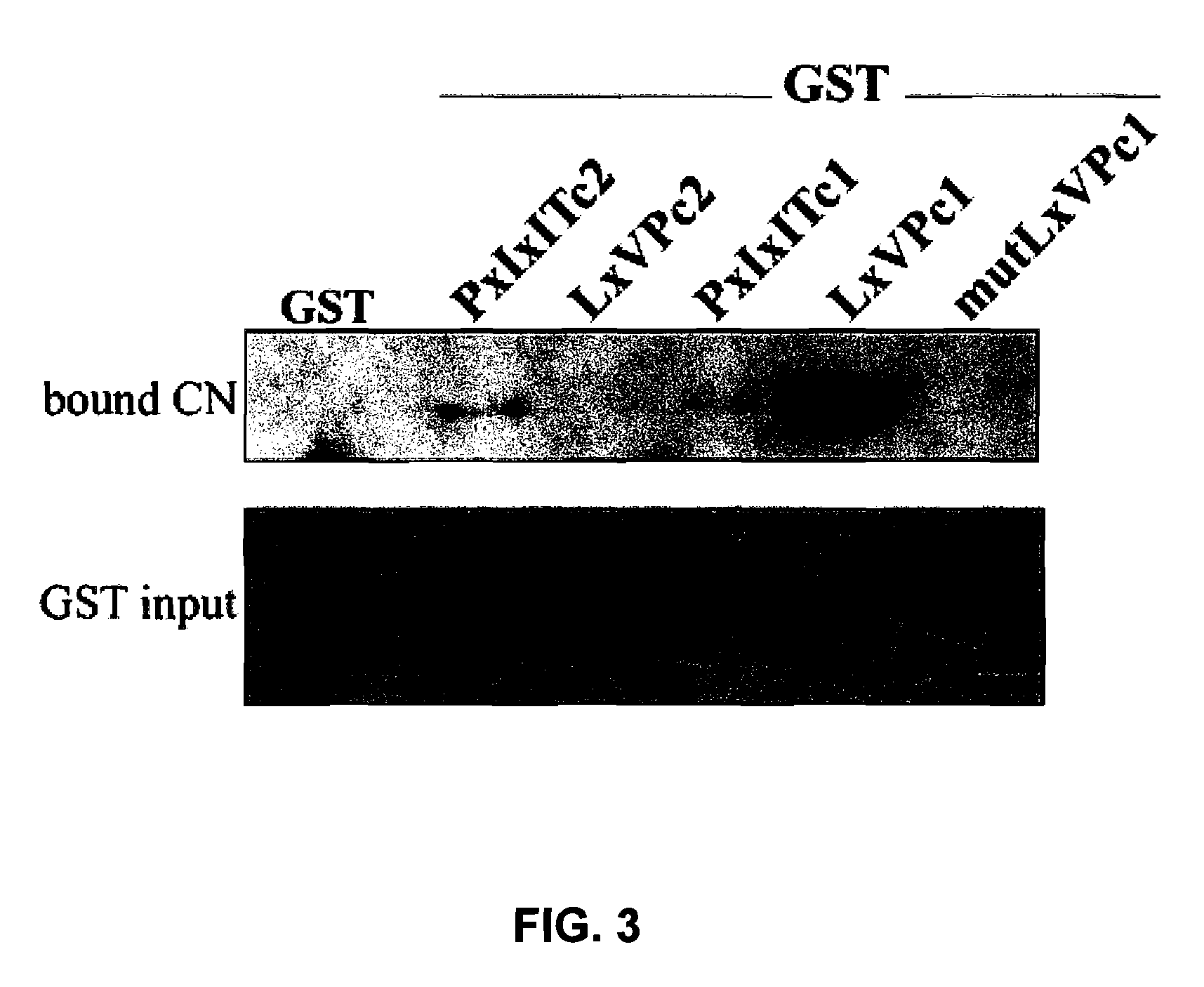Selective peptides that inhibit the biological activity of calcineurin
- Summary
- Abstract
- Description
- Claims
- Application Information
AI Technical Summary
Problems solved by technology
Method used
Image
Examples
examples of embodiments
Example 1
CN Binding to NFATc1 is Stronger than to NFATc2
[0069]In order to analyse the interaction capacity of NFATc1 and NFATc2 with CN, several binding assays were carried out in vitro. CN bound to decreasing concentrations of the purified recombinant regulatory domains of NFATc1 or NFATc2 fused to the protein GST (GST-NFATc1 and GST-NFATc2 respectively) were compared. Quantification by densitometry of the bound CN showed that NFATc1 has a binding capacity to CN of a submicromolar nature, and that the affinity of NFATc2 appears to be much lower than that of NFATc1 (FIG. 2A)
[0070]Complementary experiments were carried out in which the concentration of CN was varied. In each case, the quantity of CN bound to the GST-NFAT fusion proteins decreased as the concentration of CN was progressively reduced. However, and in accordance with the results obtained when varying the concentrations of GST-NFAT, at each concentration of CN assayed, the bind to NFATc1 was stronger than to NFATc2 (FIG....
example 2
CN Binding Capacity to the LxVPc1 Motif is Greater than to the PxIxIT Motifs
[0071]These differences in CN binding might be due to a differential CN binding capability to the PxIxIT and LxVP sites of NFATc1 and NFATc2. The second CN binding sites show a limited homology between the different NFAT members, although their alignment indicates that there are three conserved residues in all of the members (Leucine, Valine and Proline) (FIG. 1A). In order to test the interaction capability of each independent PxIxIT and LxVP sequence with CN, we fused the GST protein with the PxIxIT and LxVP motifs of NFATc1 and NFATc2 (FIG. 1A), and we used them in pull-down experiments with CN (FIG. 3). The amount of CN bound to GST-LxVPc1 was much greater than that bound to GST-PxIxITc1 or GST-PxIxITc2, while GST-LxVPc2 was incapable of binding CN under the same experimental conditions. The relevance of the amino acids conserved (Valine, Leucine and Proline) for the binding of LxVPc1 to CN was studied u...
example 3
Effect of the PxIxIT and LxVP Peptides on NFAT-CN Interaction In Vitro
[0072]Given the differences in the interaction capability of CN with the PxIxIT and LxVP sites, the capability of the peptides corresponding to said sequences of competing the binding of GST-NFATc1 with CN in vitro was assessed. The synthetic peptides corresponding to the CN LxVP and PxIxIT binding sequences of NFATc1 and NFATc2 are shown in FIG. 1A. The amount of CN bound to GST NFAT was detected by Western blot analysis. In these assays, the VIVIT peptide (FIG. 1B), a highly specific sequence selected by means of a combinatorial peptide library (29), was used as a potent control competitor.
[0073]The PxIxIT peptides corresponding to NFATc1 and NFATc2 (PxIxITc1 and PxIxITc2, respectively) had a similar potency displacing the binding of NFATc2 and CN (FIG. 4A), but there were clear differences between the two peptides based on the LxVP sequences. LxVPc1, the peptide which contained the LxVP sequence of NFATc1, inte...
PUM
| Property | Measurement | Unit |
|---|---|---|
| Molar density | aaaaa | aaaaa |
| Molar density | aaaaa | aaaaa |
| Molar density | aaaaa | aaaaa |
Abstract
Description
Claims
Application Information
 Login to View More
Login to View More - R&D
- Intellectual Property
- Life Sciences
- Materials
- Tech Scout
- Unparalleled Data Quality
- Higher Quality Content
- 60% Fewer Hallucinations
Browse by: Latest US Patents, China's latest patents, Technical Efficacy Thesaurus, Application Domain, Technology Topic, Popular Technical Reports.
© 2025 PatSnap. All rights reserved.Legal|Privacy policy|Modern Slavery Act Transparency Statement|Sitemap|About US| Contact US: help@patsnap.com



